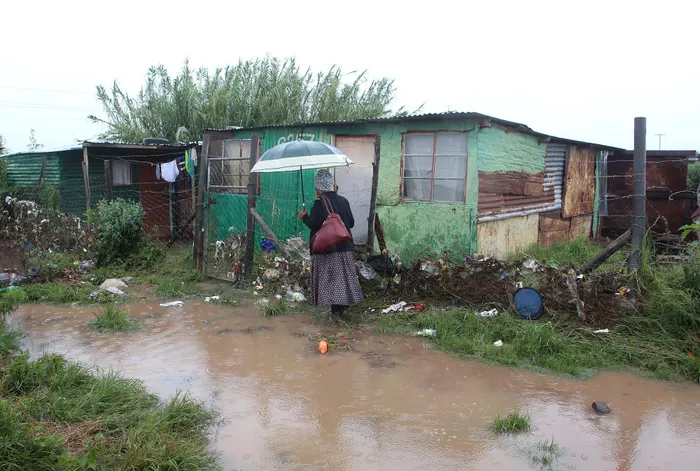Fast-tracking a just transition amid climate crises

Picture: Bheki RadebeMore than 1,000 people were evacuated from Silver town Township and eGoli township in Komani, after heavy rainfalls caused floods. The Komani River, which flows through the middle of the town, separating the town and the townships, overflowed, flooding shacks along its banks.
By Kershni Ramreddi
Increasingly, floods and droughts, which have a direct influence on the nation’s energy infrastructure, are the two climate crises that South Africa is experiencing.
It is crucial to think about how the government might expedite the just energy transition as South Africa continues to move toward a low-carbon economy to lessen the effects of climate change.
It is imperative to improve the country’s electricity infrastructure in the wake of the devastating flooding.
The South African National Energy Development Institute has highlighted five important areas of focus: decreasing energy demand and improving efficiency; increasing the supply of renewable energy; modernising the electricity grid; developing energy storage; and investigating alternative fuels.
It has committed to providing all citizens access to energy, which involves providing low-income households energy subsidies, creating incentives for energy efficiency, and giving remote areas access to renewable energy sources.
The devastation caused by the floods in KwaZulu-Natal last year and in other provinces this year offers a window into the true nature of climate change. Forty thousand people lost their homes, and more than 400 individuals are estimated to have died.
The South African Weather Service issued a warning for disruptive rainfall on April 7, 2022. The level of intensity of the warning also increased as the storm approached. The report claims, however, that “the warnings had limited reach and that the people who did hear them may not have known what to do based on them”.
Considering that so many people are unaware of climate change and what it entails, this obviously demonstrates a lack of environmental awareness, which is critical for our nation. As South Africans, we must distribute our knowledge far and wide and launch awareness programmes that are inclusive of all racial and socio-economic groups.
People must move forward in unison to create a sustainable shift, where no one is left behind and public input is genuinely considered in the decision-making processes, in order to accomplish a just energy transition.
According to Eskom’s former CEO, André de Ruyter, and the statements which were made available to the public, it can be seen that Eskom is entirely controlled by the government. “The government loses R1 billion monthly from Eskom,” said De Ruyter, which is a glaring example of the widespread corruption and fraud that is ongoing in our country.
De Ruyter had been making an effort to address the issue of energy sustainability by shutting down and reusing outdated coal-based power plants, unbundling the business, and raising money for the just transition and decarbonisation of electricity generation.
These efforts were apparently being undermined by the appropriate ministers. The departure of the Eskom CEO foresees a worsening situation of scheduled power failures. The nation is experiencing frequent rolling blackouts and must adjust to an energy availability factor of 50 percent to 55 percent on a regular basis, leaving a 4GW to 5GW generation gap.
The national key points, which consume 33 percent of the total demand, are not affected by load shedding because only 66 percent of Eskom’s demand side is affected. This means that the average consumer would experience six to eight hours a day without electricity.
For South Africa to mitigate the impact of climate change and create the sustainable future we require, the government needs to embark on the following:
1. Increase investment in renewable energy sources: To lessen its reliance on fossil fuels, South Africa should increase its investment in renewable energy sources, including solar and wind power.
2. Increase energy efficiency: South Africa should put regulations and incentives in place to promote the adoption of products and technology that consume less energy.
3. Raise public awareness of renewable energy sources’ value and potential. South Africa should concentrate on accomplishing this.
4. Encourage research and development: South Africa should make research and development expenditures to promote the creation and use of cutting-edge renewable energy technologies.
5. Provide incentives for clean energy investment: South Africa should provide incentives, such as tax credits and subsidies, for investments in the generation of clean energy.
6. Expand the availability of renewable energy: South Africa should make sure that all citizens have access to renewable energy sources like solar and wind energy.
7. Make it easier for businesses to acquire finance to invest in renewable energy sources.
8. Improve energy regulation: To guarantee that energy policies are implemented and that the transition to a more sustainable energy future is successful, South Africa should strengthen its regulatory framework in this area.
In conclusion, the government must take action to accelerate the transition to an equitable energy system and to lessen the effects of climate change. No matter their socio-economic standing, all residents should have access to energy, and the government should take several steps to minimise energy demand, improve renewable energy production, and update the power grid.
By taking these actions, South Africa will showcase how an equitable and just energy transition may be achieved.
Kershni Ramreddi is an Energy and Just Transition Project Officer at South Durban Community Environmental Alliance.